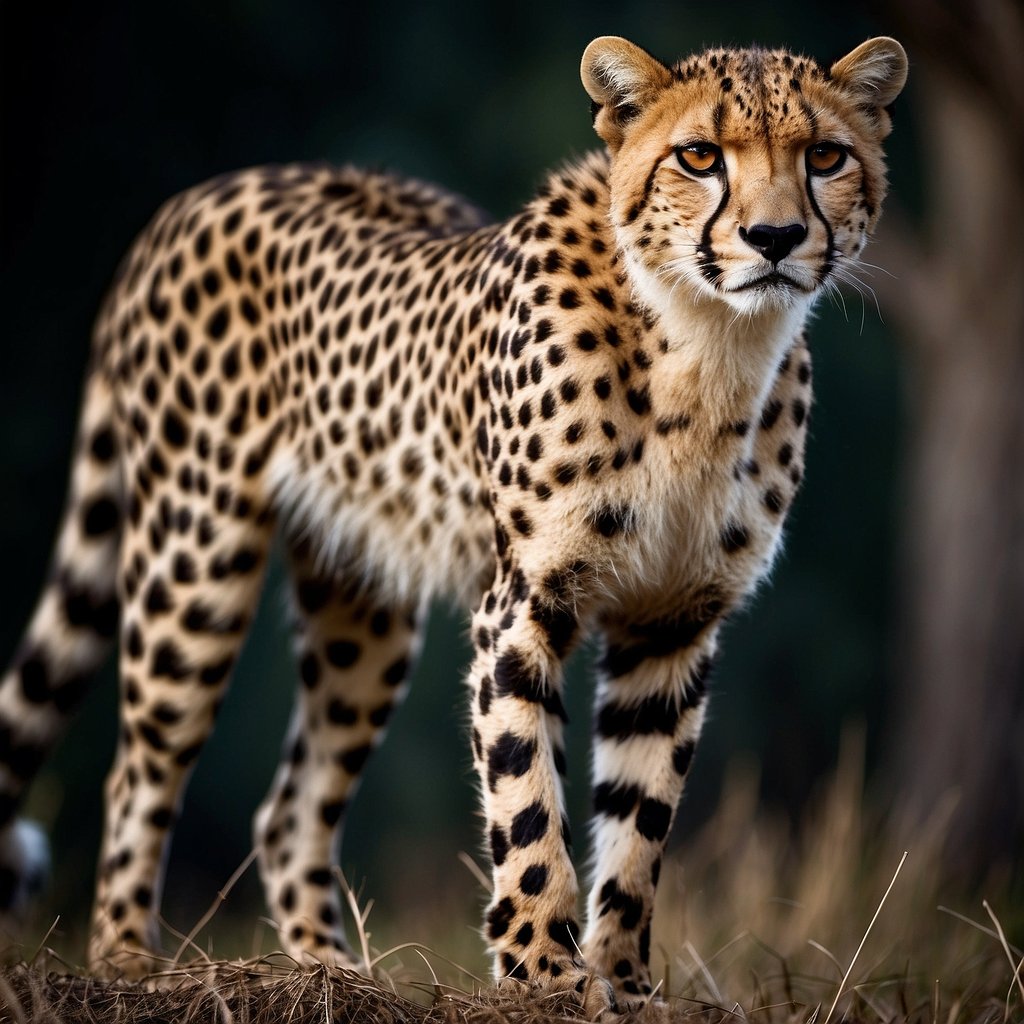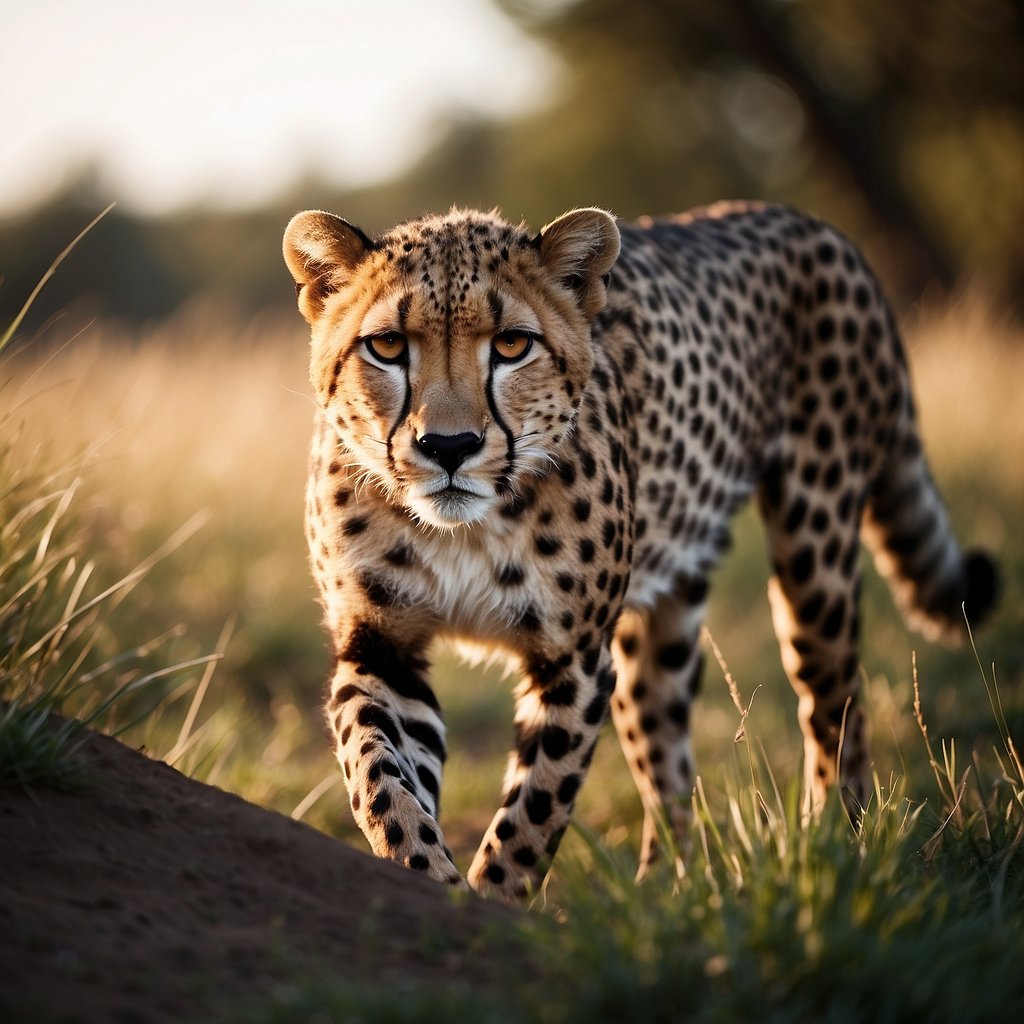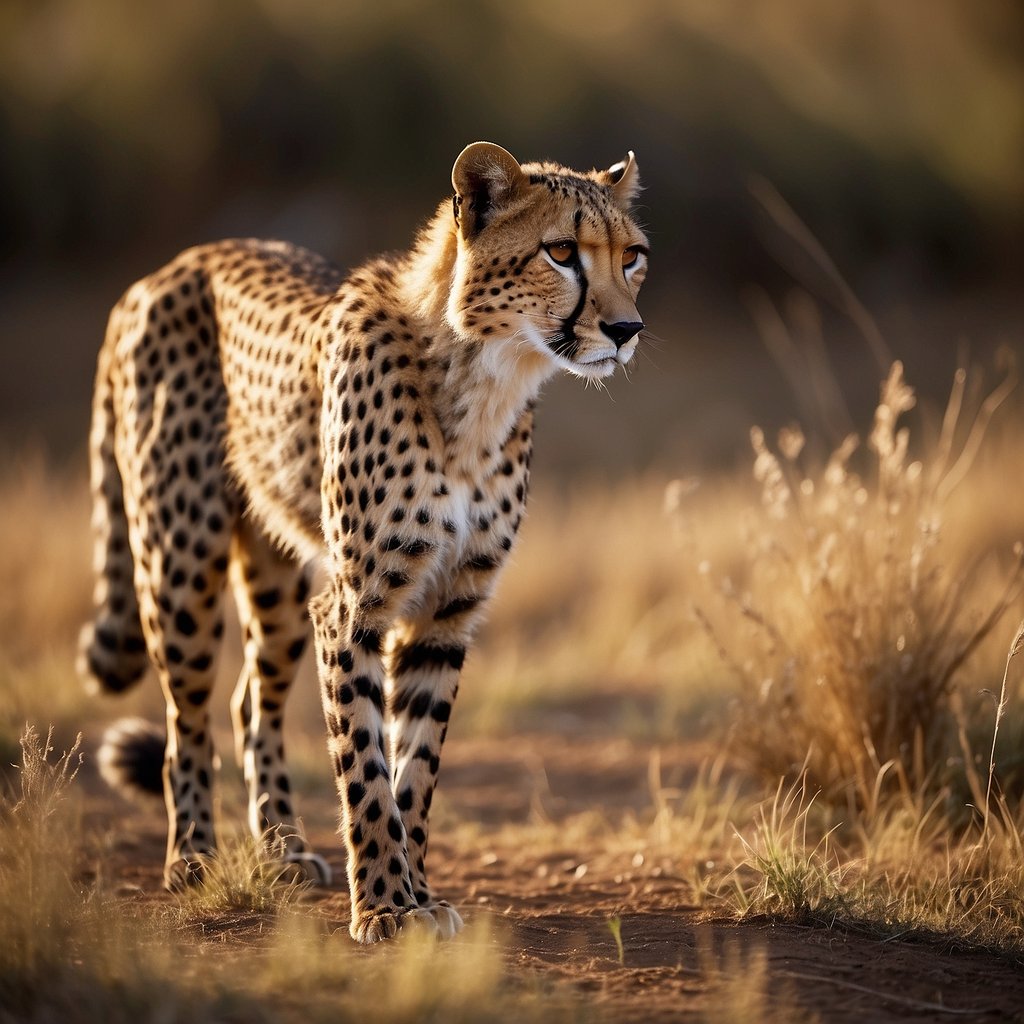
Cheetah Anatomy: Insights into remarkable speed
The cheetah is renowned for its remarkable speed, making it the fastest land animal. Native to various parts of Africa and parts of the Middle East, this member of the Felidae family stands as a striking example of evolutionary specialization. The distinctive traits that contribute to the cheetah’s agility offer a tangible look into the interplay between anatomy and functionality. Understanding the cheetah’s physical characteristics helps explain its ability to accelerate faster than any other land mammal, reaching speeds upwards of 60 miles per hour in mere seconds.
Anatomically, the cheetah is designed for speed with several unique adaptations. Its lean body, long legs, flexible spine, and enlarged nostrils for increased oxygen intake all serve to enhance its running capability. Additionally, the cheetah’s claws are only semi-retractable, providing extra grip in high-speed pursuits. Studying these adaptations not only sheds light on the cheetah’s predatory prowess but also on the broader principles of biomechanics and evolutionary biology. The cheetah’s musculoskeletal structure, particularly in the hindlimb and forelimb, is central to its ability to sprint and capture prey with such efficiency.
Physiologically, the cheetah also exhibits adaptations that support its sprinting endurance and efficiency, such as large adrenal glands for a rapid physiological response and a strong heart that pumps blood effectively during high-speed chases. While the species is currently listed as vulnerable due to habitat loss and other factors, ongoing research into cheetah anatomy and physiology is crucial for conservation efforts and may even inform bio-inspired designs and robotics.
Key Takeaways
- The cheetah’s speed is attributable to its specialized anatomy and physiological adaptations.
- Anatomical studies of the cheetah provide insight into its evolutionary adaptations for high-speed hunting.
- Research into cheetah anatomy aids in conservation efforts and may inspire technological innovation.
Cheetah Anatomy: Genetics and Evolution
The cheetah (Acinonyx jubatus) is a species in the class Mammalia that has faced challenges due to its genetic makeup. Research has shown that genetic diversity is limited, affecting its adaptability and survival.
Genetic Overview
Cheetahs display a remarkable genetic uniformity, which poses a concern for their long-term viability as a species. The South African cheetah has been the focus of studies revealing a significant lack of heterozygosity and genetic variation. This uniformity is observed across over 200 structural loci. Genetic diversity is a crucial factor in the health of a species as it can impact the ability to adapt to environmental changes and resist disease.
Cheetahs Evolutionary History
The evolutionary history of the cheetah is reflected in both its physical form and genetic composition. Phylogenetic analysis positions the cheetah within the felid family, with a distinct lineage that suggests a divergence from other big cats. Fossil records, such as those of Acinonyx pardinensis, provide insight into the morphological evolution of the cheetah, indicating the development of a specialized skull shape and adaptations like cheetah-like teeth for effective predation. This unique morphology is linked to specialized hunting behavior and evolutionary pressures that shaped the species over time.

Cheetah anatomy: Physical Characteristics
The cheetah is known for its remarkable anatomy, which supports its status as the fastest land animal. Its physique combines adaptations for speed with features that support ambushing prey.
Body Structure
The cheetah’s body is slim and aerodynamically built, with a weight ranging from 21 to 72 kilograms. The skeleton is lightweight, and the flexible spine allows for a great range of motion. It’s the spine’s flexibility that contributes to the cheetah’s distinctive high-speed stride.
- Average body length (excluding tail): 112 to 135 cm (44 to 53 in)
- Average height at the shoulder: 67 to 94 cm (26 to 37 in)
Skin and Coat
A cheetah’s skin is covered in short, coarse fur. The iconic spots covering its body hide it in its natural surroundings and are made up of black pigment. These black spots are unique to each individual and help them to maintain a low profile while hunting in the grasslands.
- Fur texture: Coarse and short
- Coat pattern: Distinct, evenly spaced black spots
Head Features
The cheetah’s head is small and rounded, which minimizes air resistance during sprints. Its large eyes are set high and have a wide field of vision, while the ears are small and rounded. With a small mouth, the teeth are notably smaller compared to other big cats, as this gives way to larger nasal passages for enhanced oxygen intake during runs.
- Eye positioning: Forward-facing with a wide field of view
- Dental adaptation: Reduced tooth size to allow for larger nasal passages
Limb Mechanisms
The cheetah’s legs are long and muscular, facilitating rapid acceleration. Hindlimbs are powerful and primarily responsible for propelling the body forward, whereas the less muscular forelimbs are for steering and balance. Unique among cats, cheetahs have semi-retractable claws which provide traction like the spikes of a sprinter’s shoe.
- Hindlimb feature: Strong muscle development for propulsion
- Forelimb function: Steering and maintaining balance during the chase
Cheetahs’ paws are small with tough pads, well-suited for traction at high speeds. The long tail serves as a rudder for making sharp turns while pursuing agile prey.

Cheetah Anatomy Specializations
The cheetah’s anatomy is fine-tuned for high-speed pursuit and rapid acceleration, featuring specialized adaptations in its respiratory, circulatory, and musculoskeletal systems, alongside enhanced sensory organs for effective hunting.
Respiratory and Circulatory Systems
The cheetah’s lung capacity and a powerful heart enable efficient oxygen intake and blood circulation, critical for sustaining high-speed chases. Adaptations in the respiratory system, such as large lung volumes, facilitate increased oxygen exchange, while a proportionally large heart pumps oxygenated blood to the muscles involved in locomotion.
Locomotion Mechanics
Cheetahs possess a lightweight skeletal structure that maximizes speed, as opposed to muscle mass for force. Their spine acts like a spring, extending and flexing to increase stride length during the sprint. The tail aids in balance, functioning as a rudder to steer at high speeds, and the claws provide traction, acting like the cleats of running shoes. The forelimb structure supports rapid acceleration, while the hind limbs push off the ground with significant ground reaction force.
Sensory Capabilities
Advanced sensory capabilities are integral to the cheetah’s hunting strategy. Sharp eyesight affords exceptional daytime vision, allowing for precise assessment of distances when stalking prey. Their eyes are adapted to discern the slightest movements, critical for an animal whose success depends on the element of surprise. The ears also play a role, picking up subtle sounds of potential prey.
Hunting Adaptations
During hunts, anatomical specialization ensures cheetahs excel against competition. Their light build provides a distinct advantage in speed over shorter distances. Specialized muscle mass delivers the explosive power needed for sudden bursts of speed, while semi-retractable claws enhance grip during rapid maneuvers. The agility for sharp turns is largely due to the flexible spine and the balancing action of the long tail.

cheetah anatomy Comparative Analysis
This section provides insight into how the cheetah’s anatomy differs from that of other large feline species and canids, focusing on musculoskeletal distinctions that enable unique locomotive abilities.
Cheetahs vs. Other Big Cats
Cheetahs (Acinonyx jubatus) exhibit several anatomical differences when compared to other big cats like lions (Panthera leo) and leopards (Panthera pardus). One key difference is the cheetah’s lighter skeleton and smaller head, which contribute to its agility and speed. Unlike other big cats, cheetahs have a highly flexible spine that allows for increased stride length during sprints.
- Spinal Flexibility: Cheetahs > Leopards
- Head Size: Cheetahs < Lions
- Skeleton: Cheetahs lighter than leopards and lions
In terms of their forelimbs and hindlimbs, cheetahs have a more pronounced muscular definition, which is vital for rapid acceleration. This contrasts with leopards and lions, who have a muscular build designed more for strength and power to take down larger prey.
- Forelimb Musculature: Cheetahs for speed, Big cats for strength
- Hindlimb Anatomy: Optimized in cheetahs for high-speed chases
Cheetahs and Canids
When compared to canids, such as the greyhound (Canis lupus familiaris), cheetahs share a similar streamlined body shape. Both species are built for speed; however, cheetahs tend to have a more pronounced limb length to body size ratio, which is a determinant factor in their ability to reach higher top speeds.
- Body Shape: Cheetahs and greyhounds both streamlined
- Limb Size Ratio: Cheetahs have longer limbs relative to body size compared to canids
The major difference lies in their hunting strategies and adaptations for speed. Cheetahs utilize their high-speed strategy in short, explosive bursts to catch nimble prey, whereas greyhounds can maintain their best speed for longer distances.
- Speed Adaptation: Cheetahs for explosive bursts, Greyhounds for sustained sprints
Physiological Studies
Physiological research into cheetah anatomy provides critical insights into the mechanisms behind their remarkable capabilities. This research gathers vital data, advancing the scientific understanding of cheetah physiology and potential medical applications.
cheetah anatomy and Scientific Research
Scholarly studies have meticulously documented the functional anatomy of the cheetah, particularly the hindlimb, which is integral to its reputation as the fastest land animal. Researchers have evaluated the bone structure and muscular formation in relation to the cheetah’s high-speed pursuits. The Asiatic cheetah has been a specific focus of some studies, with collected samples from desert populations shedding light on the morphometry of the forelimb bones.
cheetah anatomy and Medical Insights
Medical investigations have extended into the reproductive physiology of cheetahs, with detailed examination of structures such as the uterotubal junction. Such analyses are critical for understanding reproductive challenges in captive populations. Additionally, the physical condition and growth patterns of cheetahs have been a subject of evaluation, contributing to the knowledge base necessary for effective species conservation and medical treatment.

Frequently Asked Questions about cheetah anatomy
In this section, essential aspects of cheetah anatomy are addressed through specific questions commonly inquired about by those interested in understanding the unique physical features that enable cheetahs’ remarkable capabilities.
What distinguishes the skeletal structure of cheetahs from other big cats?
The cheetah’s skeletal structure is uniquely adapted for speed, with a lightweight frame, long limbs, and a flexible spine that facilitates extended stride lengths during sprints. This contrasts with the sturdier skeletons of other big cats, which are built more for strength than agility.
How do the muscles of a cheetah contribute to its speed?
Cheetah muscles, especially in the hind limbs, are composed of a high proportion of fast-twitch muscle fibers. These fibers allow for explosive speed and acceleration. The muscle structure facilitates rapid contraction and extension, providing the thrust needed for high-speed chases.
What are the unique physiological traits of a cheetah that enable its high-speed chases?
Cheetahs have enlarged nasal passages allowing for increased oxygen intake, and their lungs and heart are proportionally larger relative to their body size compared to other felines. These adaptations ensure efficient oxygen delivery to muscles during high-speed pursuits.
Can you describe the cardiovascular system of a cheetah and how it supports their agility?
The cheetah’s cardiovascular system is highly efficient, with a large heart and wide arteries, which aid in the rapid circulation of oxygenated blood. During a chase, their heart rate can soar, ensuring muscles receive the oxygen required for intense movements.
How does the reproductive anatomy of female cheetahs differ from other felines?
Female cheetahs exhibit a higher incidence of parovarian cysts, as noted in studies, but these do not indicate reproductive unsoundness. Their reproductive tract shows features not commonly evident in other feline species, underlining the need for species-specific knowledge in conservation and breeding programs.
What role do cheetahs’ sensory organs play in their hunting techniques?
Cheetahs rely on acute vision during hunts, with their eyes positioned to allow for a wide field of view and the ability to spot prey from long distances. Their hearing is also fine-tuned to detect subtle sounds of prey, adding to their repertoire of sensory adaptations that facilitate their success as predators.